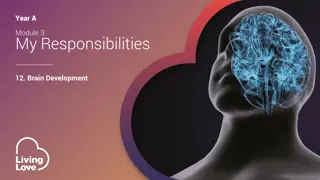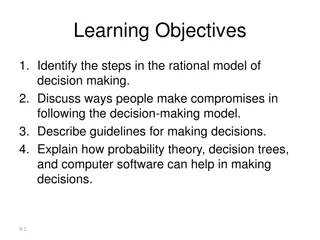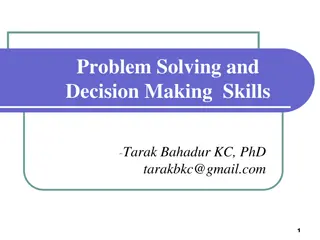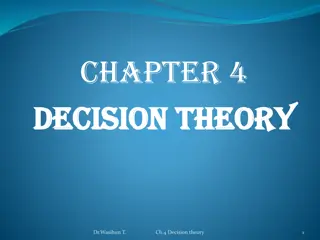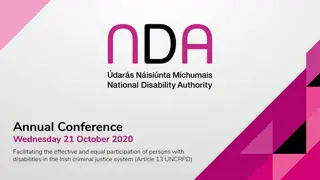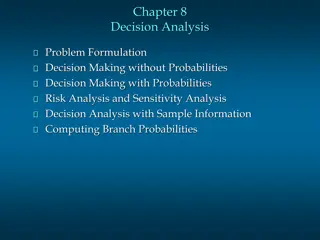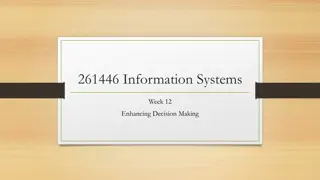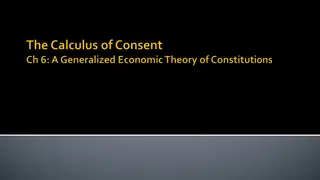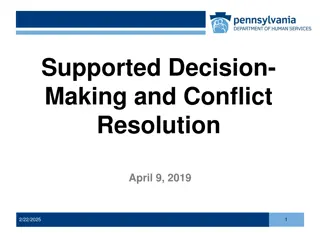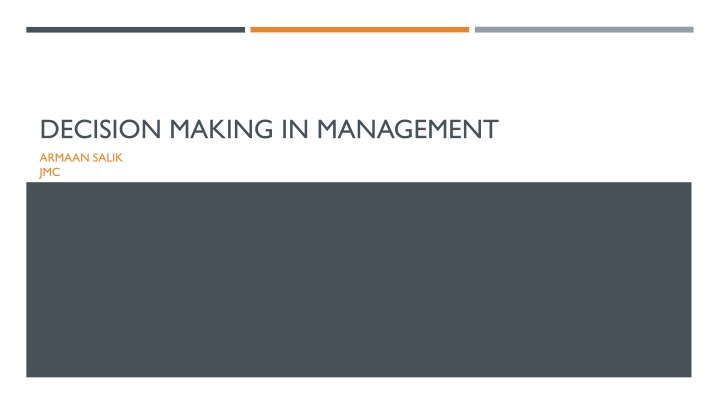
Effective Decision-Making Strategies in Management
Discover the importance of decision-making in management, different strategies to approach decisions, and the rational decision-making process. Learn how to identify problems, gather information, evaluate alternatives, choose the best option, implement decisions, and monitor outcomes for organizational success.
Uploaded on | 0 Views
Download Presentation

Please find below an Image/Link to download the presentation.
The content on the website is provided AS IS for your information and personal use only. It may not be sold, licensed, or shared on other websites without obtaining consent from the author. If you encounter any issues during the download, it is possible that the publisher has removed the file from their server.
You are allowed to download the files provided on this website for personal or commercial use, subject to the condition that they are used lawfully. All files are the property of their respective owners.
The content on the website is provided AS IS for your information and personal use only. It may not be sold, licensed, or shared on other websites without obtaining consent from the author.
E N D
Presentation Transcript
DECISION MAKING IN MANAGEMENT ARMAAN SALIK JMC
DECISION-MAKING IN MANAGEMENT Decision-making is a critical function in management that involves selecting the best course of action among various alternatives to achieve organizational goals. The quality of decisions made by managers directly impacts the success and sustainability of an organization. Effective decision-making ensures that resources are used efficiently, risks are minimized, and opportunities are maximized.
STRATEGIES OF DECISION MAKING Directive Strategy: Characteristics: Quick decisions, focused on efficiency, limited information. Typical Use: Situations requiring rapid decisions with clear objectives. Example: Crisis management. Analytical Strategy: Characteristics: Thorough analysis, data-driven, considers multiple alternatives. Typical Use: Complex situations requiring detailed evaluation. Example: Strategic planning, investment decisions.
STRATEGIES OF DECISION MAKING Conceptual Strategy: Characteristics: Creative, broad perspective, long-term focus. Typical Use: Decisions involving innovation and future-oriented goals. Example: New product development, market expansion. Behavioral Strategy: Characteristics: People-oriented, considers team dynamics and human factors. Typical Use: Decisions impacting organizational culture or employee well-being. Example: Human resources policies, team-building activities.
STEPS IN RATIONAL DECISION-MAKING PROCESS Step 1: Identify the Problem or Opportunity: Clearly define the issue to be addressed or the opportunity to be explored. Example: Identifying a drop in customer satisfaction. Step 2: Gather Information: Collect relevant data and insights to understand the situation fully. Example: Analyzing customer feedback and market trends. Step 3: Identify Alternatives: Generate a list of possible solutions or courses of action. Example: Developing multiple strategies to improve customer satisfaction. Step 4: Evaluate Alternatives: Assess the pros and cons of each alternative, considering both quantitative and qualitative factors. Example: Comparing the cost, time, and impact of each strategy.
STEPS IN RATIONAL DECISION-MAKING PROCESS Step 5: Choose the Best Alternative: Select the option that best aligns with organizational goals and provides the most favorable outcome. Example: Opting for a strategy that balances cost-effectiveness with customer impact. Step 6: Implement the Decision: Put the chosen solution into action, allocating necessary resources and assigning responsibilities. Example: Launching a customer loyalty program. Step 7: Monitor and Evaluate the Decision: Continuously track the results of the decision and make adjustments as needed. Example: Monitoring customer satisfaction metrics post-implementation.
FACTORS INFLUENCING DECISION-MAKING PROCESS Organizational Factors: Structure: Centralized vs. decentralized decision-making. Culture: The impact of organizational values and norms. Resources: Availability of time, money, and personnel. Personal Factors: Experience: Past experiences shape decision-making patterns. Cognitive Biases: Personal biases like overconfidence or risk aversion. Emotional State: Stress, mood, and emotional well-being. Environmental Factors: Economic Conditions: Market trends, economic stability. Technological Advances: Availability of new tools and technologies. Legal and Ethical Considerations: Compliance with laws and ethical standards.
OVERCOMING CHALLENGES IN DECISION MAKING Strategies: 1. Encourage Collaboration: Involve diverse perspectives to reduce biases. 2. Leverage Data: Use data analytics to inform and support decision-making. 3. Promote Flexibility: Be willing to adapt and revise decisions as new information arises. 4. Foster a Supportive Environment: Encourage open communication and learning from mistakes.

